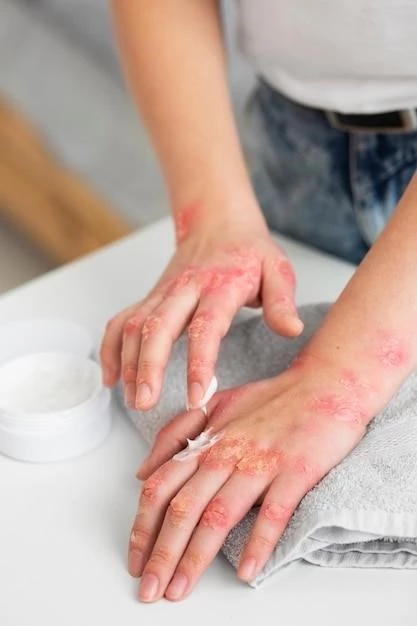Introduction to Seborrhoeic Eczema
Seborrhea is characterized by an overactivity of sebaceous glands‚ resulting in an excessive secretion of sebum. It is also used as a synonym for seborrheic dermatitis‚ a skin disorder characterized by inflammatory scaling rash.
Seborrhea‚ also known as seborrheic dermatitis‚ is a common skin condition that affects areas rich in sebaceous glands like the face‚ scalp‚ and chest. It is characterized by inflammatory scaling rash and can cause red patches‚ greasy scales‚ and itching. The condition is non-contagious and can affect individuals of all age groups‚ from infants to adults. Factors such as sebum overproduction and reactions to yeast on the skin are believed to contribute to the development of seborrheic eczema.
Definition and Characteristics
Seborrhea‚ synonymous with seborrheic dermatitis‚ is a common inflammatory skin condition affecting areas rich in sebaceous glands.
Overactivity of Sebaceous Glands
Seborrheic dermatitis is closely linked to the overactivity of sebaceous glands‚ which results in an excessive production of sebum. This excess sebum leads to greasiness and contributes to the development of the characteristic flaking skin and inflammatory rash associated with seborrheic eczema.
Association with Malassezia Yeast
Studies suggest that Malassezia yeast‚ a normal component of the skin’s microbiota‚ plays a crucial role in the development of seborrheic eczema. The interaction between Malassezia yeast and the immune system can lead to skin inflammation and the manifestation of seborrheic dermatitis symptoms.
Seborrheic dermatitis often presents with symptoms like flaking skin‚ greasy scales‚ red patches‚ and itching‚ primarily affecting areas rich in sebaceous glands such as the scalp‚ face‚ and chest.
Flaking Skin and Greasy Patches
Seborrheic eczema‚ commonly known as seborrheic dermatitis‚ is a chronic‚ relapsing form of eczema characterized by scaly rash affecting oily areas like the scalp‚ face‚ and trunk. The condition often presents with greasy scales‚ red patches‚ and itching‚ particularly in areas with high sebaceous gland concentration.
Diagnostic Procedures
Diagnosing seborrheic eczema typically involves a visual examination of the affected areas‚ focusing on the presence of flaking skin‚ greasy patches‚ and redness. In some cases‚ healthcare providers may perform a skin scraping or biopsy to confirm the diagnosis.
Antifungal medications are commonly used to treat seborrheic eczema by targeting the Malassezia yeast on the skin‚ reducing inflammation and symptoms.
Antifungal Medications
Antifungal medications are commonly prescribed to target the Malassezia yeast on the skin‚ addressing inflammation and symptoms associated with seborrheic eczema.
Topical Steroids and Anti-Dandruff Shampoos
Topical steroids and anti-dandruff shampoos are commonly used to manage seborrheic eczema symptoms‚ helping alleviate inflammation and scaling associated with the condition.
Adopt gentle skin care practices to help manage seborrheic eczema symptoms‚ including avoiding harsh products and using mild cleansers.
Gentle Skin Care Practices
Practicing gentle skin care can help manage seborrheic eczema symptoms. Avoid using harsh products and opt for mild cleansers to keep the skin clean without exacerbating inflammation.
Softening and Removing Scales from the Scalp
Softening and removing scales from the scalp in seborrheic eczema can be achieved by applying natural oils like mineral oil‚ peanut oil‚ or olive oil to the affected area‚ allowing for easier scale removal and scalp care.
Long-term management of seborrheic eczema involves establishing a consistent skincare routine‚ avoiding irritants‚ and using prescribed medications as directed to keep symptoms under control.
Long-Term Management Strategies
Long-term management of seborrheic eczema involves establishing a consistent skincare routine‚ avoiding irritants‚ and using prescribed medications as directed to keep symptoms under control.

Seborrheic eczema differs from other types of eczema by its characteristic flaking skin‚ greasy patches‚ and a predilection for areas with high sebaceous gland concentration like the scalp‚ face‚ and chest.
Distinctive Features and Characteristics
Seborrheic eczema has distinctive features like flaking skin‚ greasy patches‚ redness‚ and a preference for areas rich in sebaceous glands.
Seborrheic eczema can affect individuals of all age groups‚ from infants to adolescents and adults‚ with manifestations commonly seen in areas rich in sebaceous glands.
Occurrence in Infants‚ Adolescents‚ and Adults
Seborrheic eczema can manifest in individuals across different age groups‚ affecting infants‚ adolescents‚ and adults‚ commonly appearing in sebaceous gland-rich areas like the scalp‚ face‚ and chest.
Seborrheic eczema exhibits similarities with seborrheic dermatitis‚ sharing common characteristics and inflammatory skin manifestations in sebaceous gland-rich regions.
Clinical Similarities and Differences
Seborrheic eczema and seborrheic dermatitis share common characteristics and inflammatory skin manifestations‚ particularly affecting areas rich in sebaceous glands like the scalp‚ face‚ and trunk.
In 1887‚ Unna first described Seborrheic dermatitis. In 1894‚ Unna and Sabouraud hypothesized yeast or bacteria’s role in the condition.
Contributions of Unna and Sabouraud
In 1887‚ Unna first described Seborrheic dermatitis in adults. In 1894‚ Unna and Sabouraud hypothesized yeast or bacteria’s role in the condition‚ laying the foundations for understanding the etiology of seborrheic eczema.
Erythroderma can be caused by disseminated seborrhoeic eczema‚ known as seborrhoeic erythroderma‚ particularly in older patients.
Erythroderma and Seborrhoeic Erythroderma
Erythroderma‚ a condition of widespread redness of the skin‚ can sometimes be a complication of disseminated seborrhoeic eczema‚ known as seborrhoeic erythroderma‚ especially in older individuals.
Recent research findings have delved into understanding the pathophysiology of seborrheic eczema‚ focusing on the roles of sebaceous glands and yeast in its development.
Studies on the Pathophysiology of Seborrhoeic Eczema
Recent research findings have focused on understanding the pathophysiology of seborrheic eczema‚ particularly the roles of sebaceous glands and Malassezia yeast in its development.

Historically‚ there have been observations of Unna Nevus and Seborrheic Keratosis‚ providing insights into dermatological conditions.
Unna Nevus and Seborrheic Keratosis
The dermatoscopic observations of Unna Nevus and Seborrheic Keratosis have provided valuable insights into dermatological conditions‚ aiding in the identification and management of such skin manifestations.
Seborrhoeic eczema‚ often associated with overactive sebaceous glands and Malassezia yeast‚ can manifest in various age groups‚ leading to characteristic symptoms like flaking skin and greasy patches‚ with treatment options such as antifungal medications and gentle skin care practices to manage the condition effectively.
Summary of Key Points Regarding Seborrhoeic Eczema
Seborrhoeic eczema involves the overactivity of sebaceous glands and the presence of Malassezia yeast. It can affect various age groups‚ presenting with characteristic symptoms like flaking skin and greasy patches. Treatment options include antifungal medications and gentle skincare practices for effective management.
